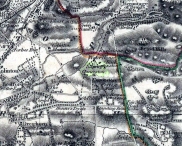Healing Well (destroyed): OS Grid Reference – NT 239 692
Also Known as:
- Three Foxes Well
Archaeology & History
A renowned site of once clear running water, the Tod’s Well got its name from being the abode of foxes many centuries ago. It was one of the five well-known ‘Comiston Springs’ as they were known—each dedicated to a certain animal—but the eternally present water in this venerable landscape was corrupted from Nature’s course by the usual Industrialists as early as 1681, so as to feed the polluting edifice of Edinburgh city. James Colston (1890) told how,
“The Town Council entered into a contract with a Dutchman, named Peter Bruschi (aka Peter Brauss) for the sum of £2,900, “to bring the water of Tod’s Well (Anglice fox) at Comiston to Edinburgh, in a leaden-pipe of a three-inch bore, to be laid one foot deep in the ground.””
When the local council upgraded the water supplies in 1820, this piping was replaced to feed the ever-needy merchants and marketeers. In Hope & Telford’s (1813) survey, the water from here was described as “constantly pure” and “excellent.”
References:
- Bennett, Paul, Ancient and Holy Wells of Edinburgh, TNA: Alva 2017.
- Colston, James, The Edinburgh and District Water Supply, Edinburgh 1890.
- Harris, Stuart, The Place-Names of Edinburgh: Their Origins and History, Gordon Wright: Edinburgh 1996.
- Hope, Thomas C. & Telford, Thomas, Reports on the Means of Improving the Supply of Water for the City of Edinburgh, A. Constable: Edinburgh 1813.
© Paul Bennett, The Northern Antiquarian
